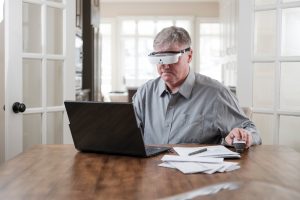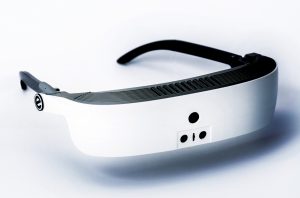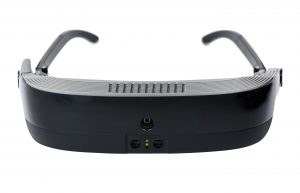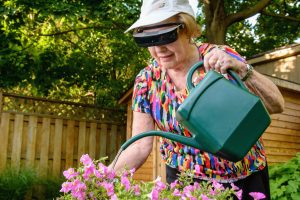
Electronic eyewear lets the visually impaired see
Stephen Law
Electronics Optoelectronics Engineering Wearable Technology wearable wearableeSight eyeglasses are built on innovative technology and years of development and millions of dollars in investment
Leveraging multiple leading-edge technologies, Toronto-based tech firm eSight Corp. has designed and developed a set electronic glasses that let the visually impaired see. Representing the only clinically-validated device on the market that enables those living with vision loss to see, the eSight glasses are worn comfortably like a normal pair of glasses, allowing the user to be mobile and engage in virtually any activity of daily living. 
Almost instantly after putting them on, an individual with low-vision can see in virtually the same manner as someone who is fully sighted can. eSight is a breakthrough technology, packed into a lightweight, wearable and clinically-validated device. There are several patents and technological innovations built on years of development and tens of millions of dollars in investment.
Here, EP&T Magazine speaks with Dr. Brian Mech, Ph.D, president and CEO of Toronto-based eSight Corp.
Q . Describe the technology behind the eSight glasses and how they operate.
A. eSight leverages multiple leading-edge technologies to deliver sight, and is the only medical device in its space to do so. eSight uses its own high definition camera and lens to capture the surroundings of the wearer, and then uses our patented prism technology and display integration to provide high quality images to each eye.

eSight also has proprietary image processing algorithms that run on the latest mobile ASIC chips for very low latency processing, enabling seamless viewing of the environment for our wearers.
Finally, the custom-built eSight frame allows for our proprietary / patented Bi-optic Tilt capability, providing wearers with the ability to use their peripheral vision and be mobile while also supporting prescription lenses via the carrier frames – a feature unparalleled in the industry.
Further describe some of the features and functions of these electronic glasses.
A. Spot Zoom – Ability to zoom out quickly for a full look at your surroundings, and then quickly zoom into a more detailed perspective as soon as any desired object of focus is determined.
Auto Focus – Allows the user to view objects with maximum clarity and sharpness. 
Zoom Function – Supports a maximum zoom function of up to 24x.
Contrast Modes – Provides the wearer with an ability to increase and decrease contrast, along with additional contrast modes in varying colors that can enable even greater visibility.
Brighter Images – Supports a wide range of brightness modes that go well above natural, ambient levels.
HDMI Input – Allows our users to connect HDMI to their personal devices to view movies, TV games and other media directly on their eSight.
Optical Character Recognition (OCR) – Allows wearers to do text-to-speech synthesis, enabling wearers to listen to books and other text should they choose to do so.
eReader – Support for PDF format, allowing wearers to open and view their digital files in the device directly.
LED Light – Provides further lighting should the wearer require it.
Bluetooth / Wi-Fi Connectivity – Enables eSight to be easily connected to the Internet.
Power Consumption – Able to support up to 8 hours of use as needed. 
Describe the background of your engineering team and what technology disciplines of expertise were required to create these glasses.
A. Our engineering team requires a diverse set of skillsets and capabilities in order to be able to develop this revolutionary and breakthrough product. It consists of optical engineers to design the lenses and sensors, hardware engineers to design the printed circuit boards and chips, real-time software engineers to do the low latency programming, mechanical engineers to do the headset design, digital signal processing engineers to implement our proprietary image processing, system test engineers to verify the full function / capability of our product, compliance engineers to enable proper compliance to certifications / medical devices, and manufacturing engineers to ensure stable high quality manufacturing of our glasses in our Ottawa plant.
Our technology team comes from well-known companies such as Lockheed Martin, General Dynamics, Alcatel-Lucent, Nokia, Honeywell, with backgrounds in products developed for use in all industries: Everything from consumer, telecom, aerospace and beyond – even tech from within the NASA Shuttle.
In addition to their engineering degrees, more than half of our team have specialized postgraduate degrees as well.
Describe the components used to create eSight glasses.
A. We use high speed mobile ASIC chips, along with our proprietary prism design and high brightness / contrast OLEDs for displays. The mechanical design is intended to reflect a lightweight, comfortable, glasses-based form factor which can best enable peripheral vision. We also have a custom controller made to enable intuitive usage, and an easy-to-use user interface within the device itself.
Describe the length of time the design process took from start to finish and share some of the key design challenges.
A. It took us more than two years to complete the full design of eSight 3, with the primary design challenge being the development and creation of the prism that allows our device to gather the light and then focus it onto the correct part of the eye for our wearers. The precise tolerance / accuracy levels we needed were challenging to implement in a manufacturing environment, so we had to devise new processes and controls to ensure that they were kept tight and accurate.
Define the size and scope of eSight’s engineering team. How important is it to have all the different levels of engineering disciplines communicating openly with each other?
A. We have about 20 dedicated and experienced engineers who work to make eSight a reality. We believe it is critical to ensure that all of our engineering disciplines work together as one to ensure the best possible technology, as we constantly have to deal with tradeoffs between size, weight, power, heat, and form factor, as well as the realities of timelines and resource requests.
Does the eSight engineering team work in collaboration with research or medical experts in other fields?
A. Yes. We have done collaborative work with world-renowned organizations such as the University Health Network, Johns Hopkins, and the Kellogg Eye Centre just to name a few.
Aside from the eSight electronic glasses, what other future design projects are you working on?
A. Our research and development is currently focused on leveraging core eSight technology to help those who are not visually impaired perform tasks that may be difficult or impossible with regular sight. While continuing to refine our technology for the visually impaired, we also intend to explore how that work can improve the safety, efficiency and effectiveness of how people can work in fields such as medicine, manufacturing, security and beyond.

Dr. Brian Mech, Ph.D, president and CEO of Toronto-based eSight Corp.
Which design element do you consider as the most critical to the success of the electronic glasses?
A. The most critical design element to the success of our electronic glasses is how it focuses on the consumer, and how we can enable sight in a way that will best improve their quality of life and ability to live independently. We understand the experiences of the visually impaired, and we do our best to figure out the best way to bring them vision exactly where and how it is needed – for example, this is why enabling mobility is particularly important to us.
We want eSight wearers to see the world and change the world.
